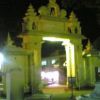බෙල්ලන්විල රජමහා විහාරය
Miraculous and marvellous temple referred to as the Bellanwila Rajamaha Viharaya, with a heritage of glorious history, stands out as the most historic and significant among the many temples in the island today. Situated on Dehiwala - Maharagama road about 2 kms away from the Colombo-Galle highway in a scenic location, originally surrounded by green fields, dating back to the Anuradhapura period.
The earliest available documentary source for the history of the temple is one of the early chronicles - Bodhivansa. From what can be gathered the history of the temple dates back to the Anuradhapura period during which time Theri Sanghamitta brought with her a branch of the Sri Maha Bodhi under which the Buddha attained Buddhahood.
Bodhivansa speaks of 40 places where the Bo saplings from the original were planted and Bellanwila is clearly stated in the list, leading to a definite conclusion regarding the origin of this sacred temple. Whatever this may mean, it cannot be denied that this temple is a sacred place, as sacred as the place where Buddha attained his enlightenment.
When examining the history of the temple it has been classified into 3 phases. The period associated with the planting of the Sri Maha Bodhi during the Anuradhapura period, is the first phase. The second phase begins with the reign of Sri Sangabodhi Parakramabahu of Sri Jayewardenepura Kotte, a generous supporter of Buddhism, who patronised the temples of the area.
The third or the modern era begins with the re-discovery of the temple by the Thera Thengodagedara after the dark ages subsequent to the Portuguese conquest. According to Professor Nandasena Ratnapala the legend says that tree worship was in existence and it has been the practice of early kings to construct temples on selected land believed to have been dedicated to divine beings, citing Ruwanweliseya as an example.
He is of the view that tree worship as a mark of respect and a sign of prosperity was prevalent at Bellanwila area and the Bo sapling was planted on a land dedicated to deities as a sign of prosperity and blessed by them. It is believed that it had close links with Pepiliyane Sunethra Devi Pirivena, due to its close proximity and that both belonged to the same complex as mentioned in the Sandesa Kavya.
There is difference of opinion regarding the name as expressed by researchers of repute. The general accepted view is that Bellanwila literally means a pond consisting of Bellan (a kind of snails) which is supported by a pond located in the centre of lush green paddy land in the east. There is still another view that it refers to a ‘wela’ (field) and not ‘wila’ meaning pond long renowned as a prosperous area of paddy land, it is believed that more appropriate should be wela, Arisen Ahubudu's version is that it denotes a paddy land in a forest rampant with Beli (a popular fruit) trees whatever the origin may be, this is and has been a magnificent temple rendering an enormous service to t







